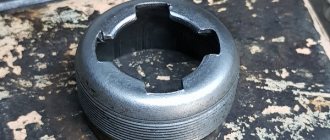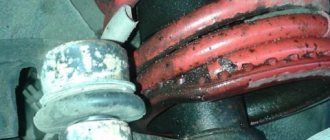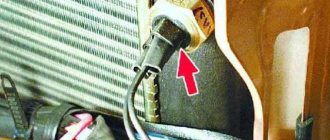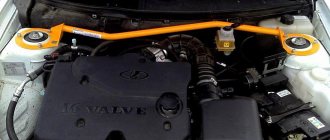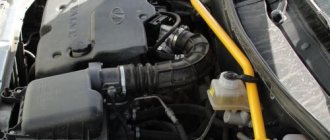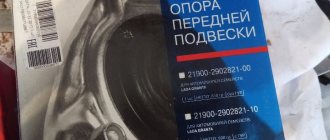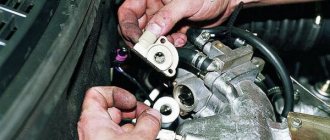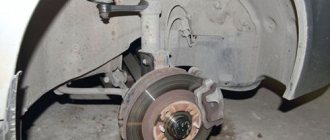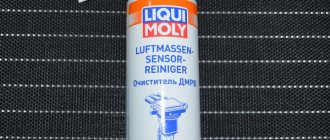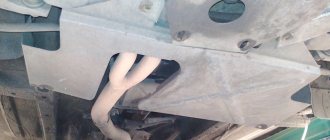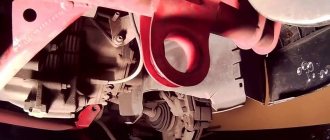see also
Comments 32
I put comfort on the front of the SS20, and after 300 km a dull knock appeared, although on the driver’s side I went through the entire suspension, it turned out that there was a small play in the strut, barely noticeable, but in the assembly there was a strong impact on the body. I changed the struts, everything was gone.
Thank you! But judging by the backlash of the prop, it’s because of it
it was the same. I changed absolutely everything (including the supports), but the sound remained. it turned out to be a rack
My support driver was hammering on the left on small bumps at low speed
What supports did you replace with?
Balakovsky staged (BRT). The previous ones were also from Balakovo, they cost 50 thousand of hard use, I didn’t see any point in installing something expensive
I don’t remember exactly, it’s like 700 rubles each (I have Priora support frames and struts). The old prop did not show himself at first, then he began to click when swinging his arms
What supports did you replace with?
Also, the hood hinges may rattle (the symptoms are the same, diagnostics do not detect the rattling noise from the hinges ). Another problem was that the spring on the front block had burst. There was a noise from outside, as if a tin can had been tied to a wheel.
). Another problem was that the spring on the front block had burst. There was a noise from outside, as if a tin can had been tied to a wheel.
No it's just a dull sound
The supporter was deaf ((
The same canoe on the 12th, and also on the right side. I climbed everything and went for diagnostics, they said if you find out, come and tell me. The entire chassis on the front end has been changed, and it also knocks on small bumps. If you find where it is knocking, please write back.
I found it! it's a support bearing
maybe a ball joint. and maybe also try tightening the caliper!
There’s definitely something in the running, but I’ve already found it
check the door hinges, I was wondering where the knock came from and it turned out to be a hinge))
I have a similar situation... First one side, then the other. In the summer, everything in the suspension was replaced except the supports. I changed the supports two years ago and installed SS20. The mileage on them is 50,000 km. With our roads, I think this is an excellent result. Ordinary supports are enough for a year, and then only with a stretch. I will take SS20 again. Maybe only Queen. Now I have standard
99% reference, I recently changed it myself. The diagnosis was exactly like yours, after the replacement there was silence.
And a couple of months ago I changed the suspension and support parts, well, recently I just noticed something, I saw something hitting the protection, but there is still some kind of dull metallic sound, maybe some kind of rack or rod thread? What could be rattling there?
ss20 simple or queen? In simple ones, there seems to be nothing structural to knock (unless the top nut has been unscrewed). I have had normal flight on a simple SS20 for about 7 years now (pah-pah-pah)... If there are cartridges in the suspension (if the boots were collapsible), the top nut in the boot could have come loose
Check the protection and exhaust - they can rattle so much that you can’t hear it from the outside, but inside the sound is just terrible. I came across this myself a couple of times on two different machines.
Everything has been upgraded to a new exhaust
Check the protection and exhaust - they can rattle so much that you can’t hear it from the outside, but inside the sound is just terrible. I came across this myself a couple of times on two different machines.
Something rattled at me too, the suspension is completely new, I blame the protection and the exhaust too
Place one hand on the support bearing, and with the other hand try to rock the car, not too much, so that the shock absorber does not begin to compress. In general, you pump slowly, if your hand feels small shocks, then the supporter is PPC... the person below already wrote about this... here is an example
Along the way they! there is a tapping! it’s a pity that it’s ss20
Look at the steering joint, you probably haven't tightened it yet
For example, I had supports. Diagnostics is simple: you hold your palm on the support, your partner rocks the car, if there is a knock or beating, then it is definitely there. try.
Checked there is tapping! It's a pity that it's ss20
I installed stock for now. and Asomi's plans. (finance finance...)
Before considering all possible malfunctions of the front suspension on the VAZ 2110, you should remember what the front suspension structure is. This is a telescopic independent suspension with cylinder-shaped coil springs, anti-roll bar, transverse lower arms with braces and shock-absorbing hydraulic struts. Of course, all car owners know that the main element of the suspension is the shock absorber. The term itself translated from French means to soften or weaken.
Automobile shock absorbers are designed, first of all, to ensure stability and controllability of the car, dampen the sprung and unsprung masses of the car, reduce body roll during braking, ensure a smooth ride and prevent the wheels from lifting off the road. Due to all the above functions, it is considered the most important suspension part in any vehicle. The safety of passengers, the driver, as well as the safety of the car depends on the serviceability of this element.
What indicates a malfunction?
This is the proverbial 20 miles of bad road. However, it's worth it for a wonderful weekend of deep woods and hiking. Getting back to civilization without the heavy load of refreshment and food seems easier on your car and your fresh, relaxed psyche. At least until you hit the pavement and start rumbling. Maybe you couldn't hear it on a dirt road, but every widening lane on the interstate makes your car sound like a tin bath full of bolts.
rear suspension VAZ 2110
| Reply Quote | |
| Reply Quote | |
| Sergey Konstantinovich Ogloblin The situation was very similar, only in front, also at ten. The knock was exactly when the wheel goes down. I changed the struts and nothing changed. Before the sale I wanted to remove it, I went to the service center, they told me that my springs were cut, not by much, but they were cut and, accordingly, I needed to take the struts for them, or not to bother and drive like that. | Reply Quote |
| Reply Quote | |
| Reply Quote | |
| Reply Quote | |
| Reply Quote | |
| 2006 car! | Reply Quote |
| what a stab. rear suspension! | Reply Quote |
| edited the post. I didn’t see that the silent bands were also changed. ok let there be a diagram. «Rear suspension LADA(VAZ) 2110, 2111, 2112 The rear suspension is dependent, with 12 coil springs and 10 double-acting hydraulic telescopic shock absorbers. The main load-bearing element of the suspension is a beam consisting of trailing arms 14 and a connector 13, welded together through reinforcements. At the rear, brackets 15 with eyes for attaching shock absorbers 10 and flanges for attaching the rear wheel axles and brake shields are welded to the suspension arms. At the front, the levers 14 are equipped with welded bushings with silent blocks 3 pressed into them. A bolt passes through the central bushing of the silent block, connecting the lever to the bracket 2. Three welded bolts are provided to secure the bracket to the body spar. The suspension spring 12 rests with its lower end on a cup welded to the shock absorber reservoir, and with its upper end, through a rubber gasket 11, on a support welded from the inside to the body arch. The lower eye of the shock absorber is bolted to bracket 15 of the suspension arm, and its rod is secured to the upper support of the suspension spring through two rubber pads 8 (one at the bottom of the support, the other at the top) and a support washer 7 (under the nut). The hub has a double-row angular contact ball bearing, similar to the front wheel hub bearing, but smaller. The bearing fit on the axle is transitional (with slight interference or clearance). During operation, the bearing does not require adjustment or replenishment of lubricant. It is not allowed to eliminate the resulting play by tightening the nut; the bearing should be replaced. When the hub is pressed out, the bearing is destroyed, so it is not recommended to disassemble the hub if the bearing is in good condition. wheel hub; 2. suspension arm mounting bracket; 3. silent block; 4. shock absorber casing; 5. compression progress buffer; 6. casing cover; 7. support washer; 8. shock absorber cushions; 9. spacer sleeve; 10. shock absorber; 11. rubber gasket; 12. rear suspension spring; 13. lever connector; 14. rear suspension beam arm; 15. shock absorber mounting bracket; 16. lower spring support cup; 17. rod; 18. upper spring support cup.” Article rating: Knock of rear pillars of VAZ 2110 Link to main publication Related publications
|
What should you do if you periodically hear noise and knocking in the front suspension of your VAZ 2110?
You shouldn’t immediately rush to a car dealership and pay for expensive, pointless services for something you can do yourself, for example, or in our case, repairing the front suspension. It should be mentioned that many motorists try to realistically assess the quality of shock absorber struts and, therefore, hold them responsible for any problem that is associated with noise and knocking from the front suspension. This opinion is not unfounded, however, there are other reasons for the phenomenon in question. Do not forget that noise occurs not only due to a malfunction of the struts, but also as a result of a malfunction of another suspension element. In this case, you should study the front suspension diagram in detail, and only then can you determine whether the front suspension arm needs to be replaced or a smaller repair can be done.
What to do if the rear pillar is knocking
When, after a run of 30,000 km, the rear pillar of a VAZ 2110 knocks
, it is extremely difficult to name offhand what is the basis for this. There may be several reasons:
- If a knocking sound is heard when driving a car on a bumpy road, then in most cases this is due to defective shock absorbers that require updating.
- If during inspection a defect (wear) of the rear suspension arm bushings is noticed, then the arms must be replaced.
- If the spring “sags”, dismantling and installation of a new part is required.
- The knocking sound is a consequence of poor tightening of the shock absorber fasteners or wear of its rubber bushings mounted in the lugs.
- The knock may be a consequence of frequent actions to overload the rear suspension or if it is defective - destruction of the buffer element of the compression stroke.
- It appears when the springs of this unit are defective, as well as when the coaxiality of the rear axle of the car is violated due to deformation of the lever bushings.
If you hear a grinding noise coming from the levers, they must be replaced. One method for detecting extraneous sounds is to empty the luggage compartment of cargo. Having decided to replace this part, you should know that the cost of the rear strut
“ten” is acceptable for Russian car enthusiasts.
Considering the design of the rear pillar, it can be noted that this unit is a dependent-action unit with springs and shock absorbers-telescopes of a double-sided design. The tens aft rack is mounted on a driven supporting structure, which consists of a set of levers, brackets with seats (eyes), silent blocks, connecting elements and other auxiliary equipment.
What indicates a malfunction?
Motorists notice a problem when they hear a knocking sound in the front suspension. It is not yet a signal that it is necessary to contact a car service, except in cases where parts have begun to break down, and even a beginner can determine this. The driver should learn to distinguish which sounds are completely natural and which indicate a breakdown.
It may be time to walk away from this car. Of course, some noises that come from under the car have nothing to do with the suspension or steering systems, but this can be difficult to determine. For example, take the exhaust system - muffler, pipe and tailpipe, and catalytic converter. If everything is not on the right side or the hangers are loose or broken, it is possible that there will be accidental contact between them and the body or drive belt, as well as the associated lever.
Try forcing the system from outside to see if you can duplicate the sound. A broken motor mount can cause severe shock. Soaking the oil could have caused it to delaminate, or perhaps a couple of bolts were loose. This condition will be sensitive to the throttle being turned on or off, but will not be detected by the bumps.
When you hear a knock in the front suspension, you should not immediately panic. This unit is quite reliable and strong. It will take a long time or strong mechanical impact before it completely fails.
Bearing replacement
No matter what kind of car the support bearing wears out, but if it uses a MacPherson strut, then the technology for disassembling the unit for replacement is identical, with the exception of some nuances regarding the suspension design.
Therefore, we will consider how replacement is carried out on a VAZ-2110 car, and then we will indicate the features of the operation on other models.
So, it has been revealed that the support bearing requires replacement. All work can be done in a garage, but some specialized tools will be required.
Problems you can fix yourself
It is worth noting that the reasons for knocking in the front suspension can be different, and there are quite a lot of them. The most harmless of them is that the motor protection has lost some of its fasteners. Therefore, on an uneven surface it makes sounds that are similar to the knocking of worn parts. However, motorists should be aware that a foreign object could also get into the suspension connections. The listed faults are easy to identify during the diagnostic process and then eliminated.
Even though we have seen people try to remove the gap in a worn bushing with sheet metal spacers, screws, etc. The only real fix is replacement. It may be more attractive and expensive than you might expect, but it comes at the cost of the world.
On the other hand, some repairs are free or nearly so. It costs nothing to tighten a strut nut and very little to replace the shock or sway bar bushings. A loose top post nut can cause a rattle that is hard to reach. You may be able to tighten it on the car.
When the car is moving, a knocking sound in the suspension may occur from shock absorbers that are out of order. This can be replaced if oil begins to leak from these undercarriage components. In this situation, it is advisable to contact a car service for repair or complete replacement, which is more preferable.
When a knock is heard in the front suspension, the cause of uncharacteristic sounds may be wear of the silent blocks and rubber-metal bushings. In this case, the car enthusiast should carefully examine the chassis levers. The driver can see the rubber on the silent blocks and bushings peeling off. In addition, if you pull the wheel towards you, if the parts wear out significantly, it will give way. In such situations, urgent replacement of these spare parts is required.
Rubber cushions, which are designed to be attached to the front axle gearbox and lower anti-roll bar arms, can fail. With good lighting and careful inspection, this can be easily noticed. The car owner will need to replace the airbags. It would not be superfluous to check the strength of the shock absorbers and the quality of the bushings for their fastenings. If malfunctions are found, you need to replace the bushings and tighten the bolts and nuts of the fastenings.
Eliminate knocking in the suspension when driving over uneven surfaces or small bumps
Probably, all car enthusiasts will be surprised by the appearance of new extraneous sounds while driving; in most cases, this is a knocking sound from the suspension when driving over uneven surfaces or small bumps. It is under such conditions that these problems can arise. They are most often used by owners of new cars who have enjoyed peace, comfort and convenience while traveling for a long period of their operation.
The appearance of new sounds is a complete surprise for owners. Knocking in the suspension when driving over uneven surfaces or small bumps is a very unpleasant phenomenon, but can be completely eliminated, including with your own hands. There are many reasons for the appearance of such knocking noises; they can later appear when traveling on a good road, so it is advisable to promptly understand the reasons for their occurrence and take measures to eliminate them.
A little about the types of pendants. Today, all cars produced have different design features of their suspensions. They largely depend on the type of wheel drive, place in the model segment, and also on the cost of the car. Some of them were used previously, others are used today and will be used for a long time.
MacPherson system
They first learned about it more than 50 years ago and since then many car manufacturers have successfully used it. It is also sometimes called a swing plug, since the shock absorber swings when the wheel moves up or down. The large camber angle of the wheels is noted as a disadvantage. But they use it because of its great popularity and relatively low price.
- Racks for VAZ 2114: selection, breakdowns and replacement
Double lever design. Experts rightfully consider it the most advanced of all available designs. It provides good lateral stability and wheel control, and optimal tire wear. The design provides for the perception of all unevenness of the road surface by each wheel separately, independently of one another.
Several levers. The multi-lever system bears some resemblance to the previous design. It consists of several levers, silent blocks, and ball joints. Thanks to this design, a good smooth ride and reduced noise from moving wheels are achieved. It is endowed with a small mass of unsprung parts, independence of all wheels, and the possibility of longitudinal and transverse adjustments.
Adaptive view system. This design is based on the use of hydropneumatic suspension, and it is very different from other types of designs. At first it had a complex design and a lot of weight. Its further improvement made it possible to get rid of some of them, but the complexity of the design remained.
This scheme was named after a French engineer, and it was used mainly for the rear axles of a car. Its main structural difference is the separation of the main gear housing from the rear axle. Torque is transmitted through axle shafts with constant velocity joints.
Disadvantages include “pecking” when starting off and “squatting” when braking. Dependent system. This type was used in the construction of Zhiguli cars, which are still running on the roads. Twisted cylindrical springs are used as an elastic element. To fix the rear axle there are 4 levers in the longitudinal direction and one in the transverse direction.
Thanks to this, good suspension characteristics are achieved. Semi-independent designs. Such schemes are used by most manufacturers in the manufacture of modern all-wheel drive vehicles. It has light weight and the best wheel kinematics. A drawback is its inability to be used on rear-wheel drive vehicles.
Why is she knocking?
Any extraneous noise from the suspension area is a clear sign of some kind of malfunction. In this case, you should find it and fix it, otherwise further damage may develop. There can be many sources of problems; they can come from all rubbing pairs when rubber bushings or silent blocks wear out.
Let's look at this in more detail. In lever systems, the source of noise can come from worn silent blocks. This can also happen when ball joints reach the end of their service life. I would like to remind you that as a result of shock loads in the support, its destruction may occur during movement.
Unfortunately, there are still Zhiguli cars on the side of the road with the wheels torn off. All types of suspensions are characterized by the knocking sound of worn steering rods, which can be detected by shaking the steering wheel. A failure of the shock absorber can not only cause a knock, but also a loss of comfort while driving. The shock absorber itself may be faulty, or the rubber bushings may be worn out.
Serious faults
Car drivers often encounter wear on the rubber-metal ball joints in their levers. They can be inspected by turning the steering wheel. If there are cracks in the top layer of rubber, parts should be replaced. It is worth noting that a knocking sound in the front suspension of a VAZ or any other car may indicate the presence of a large gap in the wheel bearings or their malfunction. To set the gap, you cannot do without contacting a car service, since you will need the work of an experienced craftsman and the use of a lift.
A fairly common cause of knocking while driving is improper wheel balancing or deformation of their discs. In case of significant damage to parts, it is advisable to completely replace them. Repairs are only necessary in cases where the discs only have cracks or minor dents.
The cause of knocking in the front suspension may be sagging springs. This also occurs when the undercarriage bounces due to weak tightening of the lever fasteners or destruction of the compression buffers. The motorist should check whether the levers, body side members and steering knuckles are deformed. In order to carry out high-quality repairs, if you notice a knock in the front suspension of a Ford or other cars, you should contact specialized centers for diagnostics and further troubleshooting.
Messages 4
1 Topic by Sanjk1980 2013-12-16 12:57:03
- Sanjk1980
- New member
- Inactive
- Registration: 2013-09-23
- Messages: 12 Thanks : 2
- Car: VAZ-21103
Topic: Knock in rear suspension
I replaced the rear struts with VAZ 21103. I installed elastomag struts, springs, and SS20 upper rubber bands. I installed everything in the service in April. Since then I have traveled 8000 km. A knocking sound appeared on small bumps in the upper right rear (that's what you hear). I checked everything was tight both at the top and bottom. I tried removing all the junk from the trunk and the knocking still remained. Tell me what else could be the reason for the knocking.
2 Reply from Wolfy36 2013-12-16 16:54:55
- Wolfy36
- New member
- Inactive
- Registration: 2013-12-12
- Messages: 19 Thanks : 5
- Car: VAZ 21120
Re: Knock in rear suspension
The cause of a knock or squeak in the rear suspension may be simple negligence of the craftsmen who installed the protection incorrectly. Very often, an extraneous knock in the rear suspension is nothing more than the knock of a loose muffler. Also check all bushings and fasteners for damage. after 8000 quiet driving it would be a sin to rely on the springs and even more so on the shock absorbers.
3 Reply from kasatik 2014-01-19 11:50:28
- kasatik
- New member
- Inactive
- From: Kharkov
- Registration: 2014-01-19
- Messages: 15 Thanks : 2
- Car: VAZ 21101
Re: Knock in rear suspension
My godfather's rear struts on the 9 were rattling. I told you to check, but no, Vitek changed it not long ago. Well, I went and checked it myself. But the rod on top of it is not screwed in, so it fidgets up and down. Alen, it turns out, held the rod with a key and turned the nut with the other. My rear struts from the Priora knock until they warm up. The front CCs do not knock. Acomi supports.
4 Reply from Maxim 2014-01-19 16:46:46
- Maxim
- Local
- Inactive
- From: Arkhangelsk region. Velsk
- Registration: 2012-03-16
- Messages: 472 Thanks : 229
- Car: VAZ 21124
Re: Knock in rear suspension
Sanjk1980 ask someone to sit behind the wheel, and climb into the trunk yourself. When you drive over small bumps, you will hear where the knocking is. I just understood that the khan stands. And I didn’t even install new ones for a week, they still made the same noise from above. I also took everything out of the trunk, it was still knocking. I bought new Kayaba struts and all the knocking went away.
Finding a problem in the brake system
In some cases, a knocking sound in the front suspension indicates problems with the braking system. It is worth diagnosing it if faults in the chassis have not been identified. The problem should be looked for in the brake pads if the knocking noise disappears when braking, but appears while driving. However, the motorist will need to jack up the car and remove the wheel. Then the brake disc with caliper and hub is turned outward. Often the pads peel off from the pads. Most often, their rapid wear is due to low quality, which happens when purchasing spare parts from unknown manufacturers.
Strengthening the support cup of the VAZ 2110 strut
Theoretically, even a new strut can tap if the hole for the shock absorber rod in the support cup is worn out. This occurs due to corrosion, improper installation of the strut, poor quality bushings and dampers. The problem can be solved by placing two washers with an internal diameter of 14 mm on both sides (top and bottom).
It is advisable to boil the washers if the glass is not very rusty. This size is dictated by the fact that the diameter of the stock rear shock absorber rod of the VAZ 2110 is 10 mm, and the diameter of the spacer sleeve is 14 mm. It is important to control the length of the thread, since when installing thick washers it may not be enough. In this case, shorten the spacer sleeve to the thickness of both washers. After this modification, in most cases the knocking of the strut disappears.
Finding a steering problem
A knock on bumps in the front suspension will be heard by the driver if individual components of the steering system break down. At the same time, everything is in order with the chassis, but the noise is clearly audible from the front axle of the car. Most often, the tips fail, in which gaps appear over time. The joints in the steering rods are subject to similar wear. You can change parts yourself only if you have the appropriate tools, as well as experience in carrying out such work. A beginner in car repair can damage the steering, which will require the intervention of experienced craftsmen.
Node check sequence
In order for the diagnosis to be carried out correctly, it must be done in the following sequence:
- Shock absorbers.
- Steering knuckles, ball joints and silent blocks.
- Levers and seals installed on them.
- Tie rod ends.
- Rubber pads.
All listed items must be in satisfactory condition. They must be intact and undamaged.
Replacing suspension parts
After a thorough inspection of the car, the driver is guaranteed to find the component that produces a dull knock in the front suspension or other components. Depending on the extent of the damage, it is necessary to repair or replace the part. It is worth noting that the second option is more appropriate. This is due to the fact that the new spare part will not soon fail, and the service life of the repaired element will still be limited. If repairs are beyond the motorist’s capabilities, he should contact a car service center.
Before considering all possible malfunctions of the front suspension on the VAZ 2110, you should remember what the front suspension structure is. This is a telescopic independent suspension with cylinder-shaped coil springs, anti-roll bar, transverse lower arms with braces and shock-absorbing hydraulic struts. Of course, all car owners know that the main element of the suspension is the shock absorber. The term itself translated from French means to soften or weaken.
Automobile shock absorbers are designed, first of all, to ensure stability and controllability of the car, dampen the sprung and unsprung masses of the car, reduce body roll during braking, ensure a smooth ride and prevent the wheels from lifting off the road. Due to all the above functions, it is considered the most important suspension part in any vehicle. The safety of passengers, the driver, as well as the safety of the car depends on the serviceability of this element.
Lada 2109 '1987 › Logbook › Knock of rear shock absorbers. Solution.
There are many posts and discussions on the Internet on this topic.
It knocks on a good half of all AvtoVAZ cars with a similar rear suspension design. A dull knock on the body. It is heard in the area of the upper nut of the shock absorber rod. I also encountered this problem. Moreover, it started knocking immediately after replacing the racks. The old ones behaved absolutely quietly, but the rod jammed inside. After the replacement, knocking noises were immediately detected, it cannot be said that it was in the pits, but when the car rocked sideways on large bumps. The struts were immediately checked and excluded from the list of possible sources of knocking. For clarity, I will give an assembly diagram of this rear suspension unit.
The first search queries give the following version - the rod knocks with bushing 8 against the edges of the hole in the body. The proposed solution is a donut that is integral with the bushing, everything is monolithically rubberized.
The decision is questionable. If the rod moves so much in the hole, then the bushing will very quickly be cut by the sharp edges of the glass, and everything will knock as before. To study the stroke of the rod, I drove it in the trunk of my own car. Yes, the rod moves in all directions. But why? Let's sort it out. The reason is immediately visible - the donuts that came with the stands are significantly smaller in diameter than the original ones. It is the donut, being compressed by the nut and tightly placed in the plate that is at the bottom of the glass, that ensures the immobility of the rod. We have a small donut - and the stock will go full blast.
A side-by-side comparison of bagels. On the right, dear. The one on the left is not my own.
Next is an important point. The top bagel is covered with a plate. I just want to place the plate with the edges down so that it squeezes the bagel around the edges. So THIS IS NOT CORRECT! The plate should lie edges up, which is very clearly visible in the assembly diagram. By the way, the plates are also different. The original one is much larger in diameter and clamps the donut over the entire area than the complete one from the rack. In the photo above it is not the original plate.
When replacing bagels, it is also worth checking the bushing so that it is not flattened. The bushing is flattened by the overtightened rod nut, it bursts open, and everything knocks even more. So, we change the bagels on both stands. By the way, it’s very easy to change without removing the rack from the car. Let's ride.
The effect is noticeable immediately. On the left, the knocking went away completely and forever. And on the right he began to appear less often, but remained. More often appears in wet weather. Why? A lot of information was read from various sources. He examined the car, rocked it, shook it.
As a result, I came across the following information. The rack in our car can be placed on either side. This is clear and can be seen from the assembly diagram. But only one position will be correct, when the tail of the lower turn is directed to the side of the car and not towards its center. Which is also revealed in the picture above and in many other books on repairing VAZ 2108-2109. My left strut was in the correct position, but my right was not. What changes from this? The point is simple. The spring at the back is very long and thin. I have never seen such long springs anywhere else. And when compressed, the spring tends to fold into an arc. So, she always does this only in one direction. And it’s bad when it folds in an arc and hits the body. The distance there is very small. We need the spring to stick out, where there is more than enough space.
So. Let's start disassembling. Right stance, before all manipulations. Installed incorrectly. The tail of the spring is directed away from us, towards the car.
We unscrew the rack from above, jack up the car, unscrew the rack from below, and remove it from under the car.
We conduct an audit of all its elements. The cup on which the boot is held prevents the rod from jumping out into the interior. It can rot (mine rotted a couple of years ago), and the rod will merrily jump out into the shelf and rattle all the way to the garage). Let's check the cup. It should fit tightly on the rod and not be rotten. I have new ones, so we skip this point.
Next we put on the bushing.
Then the native Balakovo bagel.
Then a spring with a rubber gasket. We check the gasket for breaks and tape it to the spring with electrical tape. So that it does not fall out during installation. I recently took it apart, so everything is tied up.
We put it back on the car. We put a bagel on top, a plate on top, in the same position as it lies in the photo below.
What should you do if you periodically hear noise and knocking in the front suspension of your VAZ 2110?
You shouldn’t immediately rush to a car dealership and pay for expensive, pointless services for something you can do yourself, for example, it could be an engine overhaul or, in our case, a front suspension repair. It should be mentioned that many motorists try to realistically assess the quality of shock absorber struts and, therefore, hold them responsible for any problem that is associated with noise and knocking from the front suspension. This opinion is not unfounded, however, there are other reasons for the phenomenon in question. Do not forget that noise occurs not only due to a malfunction of the struts, but also as a result of a malfunction of another suspension element. In this case, you should study the front suspension diagram in detail, and only then can you determine whether the front suspension arm needs to be replaced or a smaller repair can be done.
So, the main causes of noise in the area of the front suspension on the VAZ 2110:
- The bolts that are responsible for attaching the anti-roll bar to the bar body may have become loose;
- The rubber part of the strut support has severely settled or collapsed;
- The front suspension may make noise if the upper strut mount is loosened significantly to the body;
- The braces, front suspension strut or rubber-metal joints of the lever and suspension are worn out;
- Rubber cushions of stretch marks or barbells have become unusable;
- The compression stroke buffer has collapsed, so a knock is heard in the front suspension;
- The front suspension lower arm or control arm joint is worn;
- The suspension spring has settled, deformed or broken;
- Lack of wheel balancing.
Upon careful inspection, even a driver without special skills can detect such malfunctions. All of the listed causes of noise and knocking can be eliminated by tightening fasteners that have become loose or by replacing worn elements with new ones. Every self-respecting car owner should have a manual for the operation and repair of the car; it is this instruction that will help you fix the problem. The most important thing is to examine in detail the design of the front suspension and determine the cause of the knocking.
The problem of wheel balancing should be considered separately. It is advisable to visit the nearest car service center that has a decent balancing stand. The service in question is quite inexpensive, and besides, imbalance can affect not only noise, but also directional stability during straight-line driving or uneven and premature wear of car tires. For one thing, ask if there are any malfunctions in the brake system?
What should be the conclusion after all of the above? Remember, as soon as you hear a knock or noise in the front suspension of your car, it is not at all necessary to immediately go to a car dealership or buy a huge number of expensive imported shock absorber struts. Often, repairs to such problems are limited to replacing the rubber cushion or even simply tightening a few fasteners.
When it comes to your own car, knowledge will not only be strength, but also a factor that will help you significantly save on car maintenance and repairs. Thus, by following the tips below, you can quickly fix your car if you hear a knocking noise in the steering rack or front suspension. You will also be able to replace the wheel bearing.
- If there is a high imbalance of the wheels, have them balanced at a car service center, replace the buffer if it is damaged.
- The spring should be replaced when it breaks or sag.
- The ball joint is replaced when it is worn out or deformed.
- Other hinges must be replaced when they are worn out or when the stabilizer bar struts are worn out;
- Replacing the rubber element of the strut support when it is destroyed or settles;
- If the upper strut mount to the body is loose, tighten it;
- Worn cushions need to be replaced, and the bolts must be tightened if they are loose or the rods and stretch pads are worn out.
Video - “Replacing the front and rear struts of a VAZ”
avtoexperts.ru
What could be knocking from behind?
As you understand, the overall design of the suspension is quite complex; it is a certain set of mechanisms and devices that are the connecting link between the body and the road itself, through the wheels. If we compare the design of the rear part, it is in many ways simpler than the front. Units can fail for a variety of reasons. And the “first sign” of the appearance of any problems is considered to be a roar coming from the rear.
It's not just the suspension that can be to blame for this. So, you need to initially discard:
• Loose tools in the trunk, under the false shelf. It is not uncommon that the spare tire mount could be torn off.
• The exhaust pipe has come off.
• A rear seat backrest that is not fully secured causes trouble.
• And exotic, like a torn off or unfastened bumper.
By the way, the last reason, oddly enough, is found in huge numbers on domestic cars, the Samara, Tens, and Priors families. The reasons lie in loose bolts or worn rubber bands.
If, after the inspection, none of the above was found, it is necessary to begin diagnosing the complex as a whole, and it is important to pay attention to each mechanism.
Malfunctions and solutions
Let's make a list of the most common suspension problems that can cause knocking and other unpleasant surprises awaiting the driver. Let's briefly look at the repair features. So:
1. Shock absorbers . Most drivers usually encounter them. It’s not difficult to guess why elements wear out, bad roads, inaccurate driving. Try to be as attentive as possible to such components; not only the presence or absence of unfortunate sounds depends on them, but also maneuverability and overall controllability.
A great misconception among domestic motorists is that racks can only knock at the installation sites. In addition to the fastening, the rod entering the piston may knock from above or below, the gasket (bushing) is “eaten” and it begins to hit the body. The problem is difficult to notice without a full diagnosis and removal of the entire assembly.
If the real culprit is the strut, that is, the bolt has come loose from below or from above, then just tighten it and replacement will not be required. When the problem is in the rod itself, it is more effective to replace the entire assembly, without disassembling the shock absorber and repairing it.
On most cars, the rear pillars are attached to the body through a rubber damper, also known as a compression buffer, that is, an ordinary rubber “washer” with a height of 2 to 5-6 cm, which is placed on the rod, depending on the model. Often the rubber material is of poor quality; as a result, the gasket becomes woody and no longer copes with its absorbing functions. Replacing the rubber band will solve the problem.
2. Springs . Depending on the modification of the machine, they can be installed either separately from shock absorbers or in pairs with them. Pay attention to the structure of the suspension of the VAZ 2110 and similar ones; their shock absorber goes along with the spring. In another car, let's take the Daewoo Lanos, the strut and spring are installed separately. In principle, in our case there is no global difference in this.
Pay attention to the condition of the turns, count an equal number, because it often happens that a couple of turns break off and the spring bursts.
Pay attention to the condition of the gaskets; rubber or polyurethane inserts for springs often crack, break, and wear out. For example, if the wear is severe, the sharp part of the coil may “reach” the metal “cup” and hit it.
3. Silent blocks, levers, beam.
It's hard to imagine them apart. Worn silent blocks can be repaired in one way - by purchasing new ones. Polyurethane parts cannot please us in terms of durability; they very specifically withstand all the hardships of domestic road surfaces, especially outside the city.
It is easy to diagnose a malfunction; if there is play at the junction of the levers (guides), then the silent block needs to be replaced. The development of the elastic band and bushing leads to direct contact of the metal elements.
